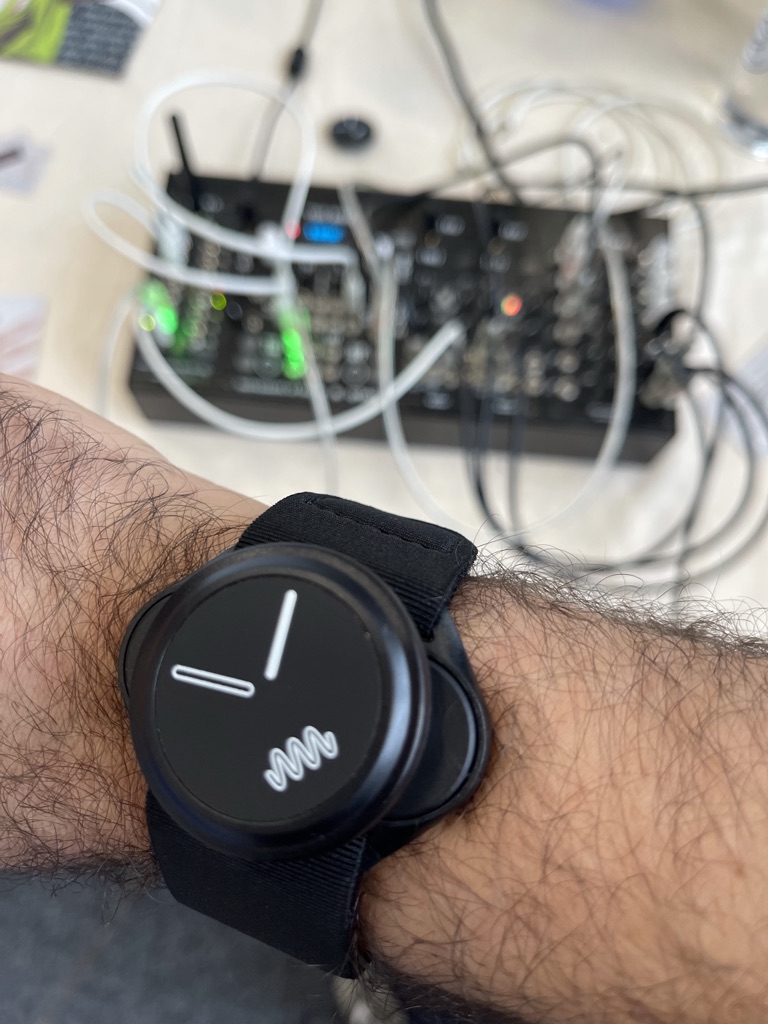Next-generation wireless and motion-sensing technologies – they’re in your smartphone already, but they’re finally coming in usable form to your music rig. And that means new possibilities for using movement as an input.
“Hey, wouldn’t it be great if we could put some sensors on these dancers?” or “what if I could make some gestures with my hand as a controller?” are questions that get asked with some regularity. And I don’t know that I have ever attended a music tech/instruments show that didn’t have some product intended to do this. But while it’s not hard to create a tool that does something, these solutions have tended to have poor sensor accuracy, latency or connectivity issues (or require tethers to get around them), or a combination.


SOMI-1 is one of the first tools I’ve tried that actually works the way you’d want. It won’t be cheap, but they get you something more like the precision of sensor/accelerometer and wearable technology you’re starting to see in advanced consumer tech like the iPhone and Apple Watch, adapted to the performance characteristics and I/O flexibility you need for music and performance use.
Now, whether you necessarily want to do that with your synths remains an open question. But if you do, this is now immediately the state of the art. And it’s made by folks who care and know what they’re doing. The Kickstarter will let you get onboard for EUR379 with a deep early bird discount.
German startup Instruments of Things has been working on making an integrated system for a while, sharing a lot of what they do as kits and open source tech. One reason I like talking to them is that they’re engineers and open about what they’re doing – so you don’t just get a bunch of marketing spin.
And basically what we get now is a convergence of folks who care with tech that has finally matured – Bluetooth wireless that is low latency and connects properly without consuming a lot of power, for one.
For this kind of input to be useful, you want sensors that are easy to wear, plus a way of connecting to your music gear. Accordingly, SOMI-1 is really a complete system of stuff. You can plug into the phone and get things working right away – which I imagine could be important working in a dance studio, for instance. But you can also connect with MIDI and whatnot.

Specs from the company:
- Wearable sensors (the things that look like wristwatches), reasonably comfortable to wear (even though this is obviously a much smaller company than Apple or Samsung)
- 8 movement parameters per sensor, configurable – activity, acceleration, tilt, in all directions
- Bluetooth 5 wireless
- Smartphone app (Android/iOS) with configuration but also internal sound generation – so it’s friendly for use by dancers and choreographers, too, without them needing to know what to do with MIDI and DAWs and things
- Hub with USB and TRS – so you can connect something like a Teenage Engineering OP-Z (via USB) or any MIDI gear
- Connect directly to music software and hardware, too, in case you’d rather use your computer or DAW or Eurorack modular or whatever
- Works with up to six simultaneous sensor inputs
- 50-meter range (164 ft)
- < 10 ms latency (keep in mind you need to add in any additional latency from your computer, but tht’s still impressive for wireless input)
It’s already cool, and perhaps also understood as a creative demo of what their sensing technology can do. It feels musical to use so far, though I’ll be curious to try it for a longer period of time – and see how dancers work with it.
It’s obviously an artistic and creative passion project, evidenced partly by the fact that they (cough) are targeting the modern dance community. But that’s often where real innovations can originate.
There are other connectivity options, too. Artist JakoJako at Superbooth (seen here before) used their 2.4SINK kit with a dancer. (I’ll see if they release video of that performance.) It’s a big deal to have this be wireless – she was able to play with her modular from across the stage. That project allows other connectivity, too, via Ableton Link, OSC, and Bluetooth MIDI, and then gives you a Eurorack module with a load of CV banks to you can easily patch into other stuff. The new SOMI-1 is a follow-up – with that clever hub and more software – building on what the Eurorack kit started. (You can also add on the hub if you want.)

There’s more software to get you started, too. Apart from giving you MIDI out of the box, there’s a Max for Live tool for Ableton Live with additional parameter control and preset projects (as seen briefly in the video).
Lots of additional details on their Kickstarter:
PS, perhaps for prototyping before you invest in a system like this or depending on your use case – there are apps that translate data from your iPhone, for instance, as in:
That particular project also had its own hardware, though it appears to be awaiting a 2021 update (and everything is on the egde this year with supply chain madness).
The accuracy and completeness of this new system from IOT is impressive, though, versus a host of past projects.